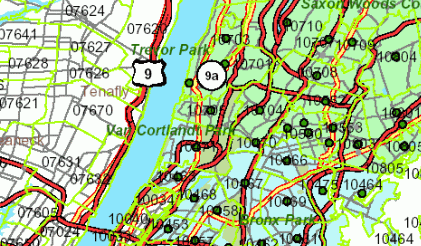
There has been plenty of discussion about "proving" the ROI (return on investment) of GIS and location technology. Naturally, there are many differences of opinion from vendors and users about what we're even talking about. Yet, that does not prevent a consensus from emerging.
At the recent Symposium on Location Technology and Business Intelligence, Jack Dangermond, president of ESRI, claimed that the "business value" of GIS is proven: textbooks have documented this; it is in the literature. In support of Dangermond's contention, we heard some fine presentations by people in the trenches who are actually doing site selection, logistical design, and other high value analyses for their businesses.
Many people noted, however, that business leaders remain "conservative" (Paul Overberg, USA Today) and "unaware of GIS" potential (Jack Dangermond). Dangermond offered an explanation to support his observation: he traces it to "work flow legacy" within the business. Managers are reluctant to change systems that work (sort of) for new systems that might work better, but will require the business processes to change.
OK, that makes sense-I saw that stuff first-hand when I was developing database systems in the 1980's-but I think there's more going on here than people were admitting.Brady Foust (Proxix and the University of Wisconsin) provided some insight. This stuff (meaning GIS analysis) is hard, he says. Over the years, plenty of statisticians have come along, looked at these problems, and figured they could solve them in a few weeks and make their fortune. But, according to Foust, they have all tried and failed. It's hard!
The message here is that there is plenty of money to attract good thinkers and develop creative ideas and excellent tools to solve business problems. Well-this is my humble opinion-maybe not. Where does that money go? Probably very little actually supports creative thinking and research: most of it goes into buying and maintaining basic enterprise systems. Any research that is done is often hugely biased: it is conducted by people and companies developing and marketing products or services. The research has to succeed; it has to look good. The standard of proof in much business research, in case studies, is so low as to be almost worthless.
Business people are not fooled by this.
A case study
Let me offer you a small example. The conference offered several fine examples of GIS market analyses, but one was especially intriguing. The objective was to optimize a local advertising campaign. The company, a large national firm with thousands of stores, had located three new stores in a city. Initially relying on the advice of the local newspapers, they had blanketed nearby neighborhoods with advertising inserts. In addition, store customers routinely provided their addresses, so this company quickly developed a reliable database of customer locations.
The analysis used GIS to map customer locations relative to the stores,
overlaid on the outlines of the advertising regions. The GIS work
was truly well done. The result was classic: most customers came
from nearby, gradually tapering off with distance. Solely because
of this map, the analyst concluded that it was uneconomical to continue
advertising in the more far-flung neighborhoods that attracted only 20%
of the customers. The company apparently followed his recommendation
to limit advertising to the nearest neighborhoods.

But was this the right decision? I don't know (nor, probably,
does anybody else), but quite possibly it was exactly the wrong one!
Suppose, for instance, that people tend to patronize the nearest store.
That means these stores would naturally-perhaps with no advertising at
all-attract customers from the nearest locations. Perhaps they had
already maximized their ability to pull in the nearby customers.
Maybe, in fact, the presence of customers in the more distant neighborhoods
was really evidence of the power of the existing advertising to draw more
customers in. If this were the case, then increasing the advertising
in the distant neighborhoods, rather than terminating it, was the right
way to increase profits.
At least in this case, we do not know the right answer. The reason is simple: this business experiment-for it truly was one-was conducted without any controls. There was no basis of comparison of the "treatment" (advertising) against a neutral situation, or "control" (no advertising). As scientists and statisticians have learned to their dismay, again and again, failing to follow these basic experimental precepts can-and sooner or later will-lead us into fooling ourselves. ("Dewey defeats Truman," the polls said.)
Until we can produce legitimate, scientifically defensible experiments in GIS business applications, we will fool nobody. The problems may be difficult, but we can make progress. Until then, businesses are right to be skeptical and to be conservative.